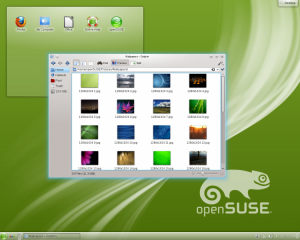OpenSUSE's new Linux distribution is for the clouds

When Novell was bought by Attachmate, people wondered if Novell/SUSE's community Linux distribution, openSUSE, would even survive. Now, we know, openSUSE lives.
The openSUSE Project has released the latest version of its popular Linux distribution openSUSE 12.1. In a statement, Jos Poortvliet, openSUSE community manager for SUSE, said, "OpenSUSE 12.1 represents more than eight months of worldwide effort to create one of the industry's best Linux distributions. The openSUSE distribution and its thousands of open source applications are the result of contributions from individual testers, writers, translators, usability experts, artists, ambassadors, packagers and developers having a lot of fun working together to create a uniquely powerful set of tools and capabilities."
So what does that mean? Well, among other things even more so than Ubuntu, openSUSE is embracing the cloud.
By leveraging SUSE Studio, SUSE's roll your own Linux distribution program, you can build and deploy openSUSE 12.1 instances with your own custom package selections, artwork, scripts, etc. directly to Amazon EC2 or other cloud platforms.
Want to run a private cloud? No problem. OpenSUSE comes with customized Eucalyptus, OpenNebula and OpenStack. It also supports ownCloud 2. This is a do-it-yourself Web-based storage cloud application. OpenSUSE claims that "ownCloud is different from solutions like Google Docs, Dropbox or Ubuntu One in that it lets you own the data."
Well, I believe the others let you own data as well, but what ownCloud does bring to the table is the ability, with the Mirall installation tool and client software, to relatively easily set up own private cloud for storage, music-sharing and calendaring and contact management.
Moving from the cloud to the desktop, openSUSE uses, I'm sorry to say GNOME 3.2, the Linux desktop interface I most love to hate. Fortunately, it also includes the far superior KDE Plasma Workspaces 4.7 as default desktop.
The new openSUSE also includes a pair of tools, Snapper, that lets you easily retrieve older versions of files and revert changes or even roll back system updates and configuration changes. Conversely, it also comes with Tumbleweed, which you can use to update your system with rolling updates that contain the latest stable versions of all software. So this way, you can stay on the cutting edge with Tunbleweed, but then back off it if turns into the bleeding edge with Snapper.
Speaking of the cutting edge, openSUSE is also the first major Linux distribution to ship Google's Go programming language.
Sound interesting? You can download a copy of openSUSE 12.1 and check it out for yourself. There's an everything and the kitchen-sink DVD version, a network upgrade version for people already running openSUSE and live CD-sized versions featuring the GNOME and KDE desktop. I've already got mine.
Related Stories:
openSUSE 12.1 debuts cloud, virtualization, Google Go support
The Linux desktop is dead. Long live the Linux desktop.
Fedora 16, Red Hat's new community Linux distribution, arrives
